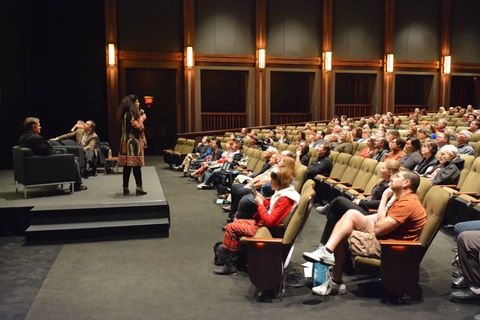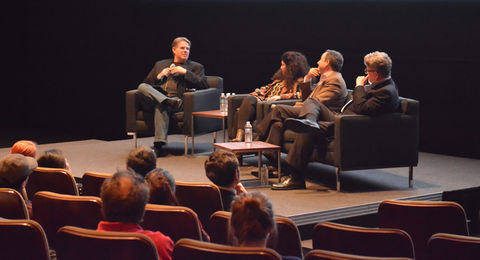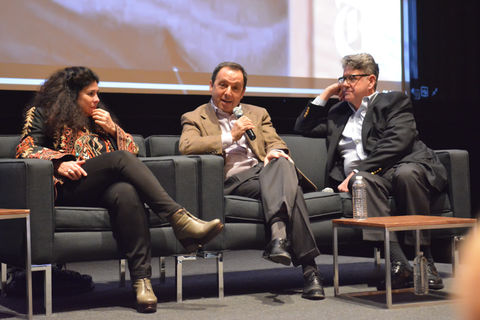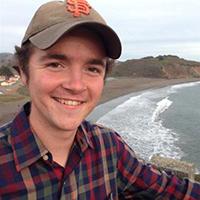“The usual hero adventure begins with someone from whom something has been taken, or who feels there is something lacking in the normal experience available or permitted to the members of society. The person then takes off on a series of adventures beyond the ordinary, either to recover what has been lost or to discover some life-giving elixir. It's usually a cycle, a coming and a returning.”
–Joseph Campbell

Legendary mythologist Joseph Campbell helped the world see the power of storytelling in a new way, and in effect influenced a whole generation of storytellers, including the likes of George Lucas. This power was evident in the story of one boy, whose tale became the heart of one of the museum’s most memorable programs.
The Letterman Theater of Lucasfilm
On Saturday, January 10, the Walt Disney Family Museum hosted guests at the Letterman Theater of Lucasfilm. Four charismatic individuals were present to discuss an inspiring topic, the power of Disney storytelling and its effect in the lives of children within the autistic spectrum. First was Jeff Kurtti, celebrated Disney historian, then Byrna Siegel, an expert in autism from UCSF, followed by Ron Suskind, Pulitzer prize winning journalist, and his good friend Jonathan Freeman, actor extraordinaire and voice of Jafar from Disney’s Aladdin (1992). The result was a panel discussion rich in emotional power.
How Disney Films Connect With Children With Autism
With Kurtti providing context and moderation, Siegel began by introducing the audience to the science of autism and the effects that artistic expression can have on children within the spectrum. “Disney is that basic Rosetta Stone for children with autism,” she would say. “It becomes a building block of their visual vocabulary.” Suskind and Freeman followed with passionate and inspiring recounts of their direct experiences with this “Rosetta Stone.”
At the center of the discussion was the story of Suskind’s son, Owen, told in his book, “Life, Animated.” The story of Owen’s struggle with autism, and his family’s struggle to connect with him, ends almost like a fairy tale, as Owen learned to reconnect and communicate via the watching of Disney films on tape. Even more inspiring is Owen’s harnessing of the mythic morals used in the many Disney films as devices to assist in his own life as an adult.
Owen Kurtti’s Experience With Disney Movies and Autism
At the age of three, young Owen began to show signs of autism. He could no longer speak. His family felt as if they had lost who he was. This however, was in the era of home video, and Owen buried himself deep into the Disney mythos, endlessly watching film after film. Eventually, he began to speak, reciting lines of dialogue from The Little Mermaid (1989) or The Jungle Book (1967). Later he taught himself to read by scanning through the end credits. His family had found a doorway back into his life. And Owen had found a doorway back into the world.

The Disney Storytelling Formula Resonates With Everyone
Connections with Joseph Campbell’s themes were discussed during the program, and this writer explored such themes deeper with both Suskind and Kurtti afterwards. “These are the stories and structure, though the form and specifics often change, that humans have been telling themselves for thousands of years to make their way in the world,” Suskind comments. The journalist himself has long admired the writings of Campbell, and draws a direct connection between the mythologist’s conclusions and the experiences of his son. In many ways, Owen is an embodiment of Campbell’s principles.
Suskind continues, “Without [myth and legend] we shrivel and die, without hope we’re like a bird with a broken wing, as Langston Hughes says. So Campbell gets that. Owen gets it too, without knowing Campbell. Many kids in the autism spectrum, because they’re not taught otherwise, can hear those lessons.” There is a purity of outlook that comes from Owen’s difficulties with “traditional” learning approaches. He harnesses the power of these Disney stories exactly as Campbell describes.
Stories Are a Way to Understand Life
Both Suskind and Campbell observe that western culture has moved away from this appreciation of myth and legend, “we push it to the edges of what is sustaining for society,” as Suskind says, and often relegate it to the “children’s department.” Those who indulge in the power of story for inspiration in their lives can be criticized as “escapists.” But Suskind retorts, “It’s not an escape from life, but an escape into life… they’re pathways into a deeper understanding of what gives life its consistency.”

Disney’s Continuation of Tradition
Disney remains today one of the strongest continuations of this mythic tradition. For Kurtti, this came naturally though was perhaps not a direct intention of Walt’s. He simply told stories as best he could. As Kurtti says, “Campbell quantified and explained for a resistant audience the things that Walt simply did by instinct. In an intellectual context and community where the conventional wisdom was to dismiss and ridicule Walt and his work as trivial, derivative, or overly 'commercial,' Campbell made scholars take heed of the fundamental human power of what Walt created, and to examine his work with less of an intellectual predisposition to derision.” Suskind proves the case study, “This is not a prevailing view in the academy… But I was taught otherwise, often against my will, by a boy who was struck silent and had no other choice but to live almost exclusively for many years on a diet of myth, fable, and legend. He ended up being my teacher.”
The Sidekick is The Real Hero
Owen has developed his ideas entirely on his own, and as a result has carried them beyond even Campbell’s definitions. For Owen, the sidekick—not the hero—is of greatest interest, be it Jiminy Cricket or Rafiki. As his father states, “He has come up with his own original version…that we are all really sidekicks. And what does a sidekick do? They’re at their best as they help someone else […] fulfill their destiny. And I think the notion that we are at our best when we help others fulfill their destiny is a very powerful idea and is very spiritual.”
Disney is The New Myth
In a modern world that is heavily saturated with media, particularly amongst young people, the story of Owen Suskind is a light in the dark, a gleaming ray of hope and inspiration. Owen is a more extraordinary example of something that we are all capable of. Now an adult in his 20s, he quotes Disney films like a scholar who has spent his life pouring over ancient texts. And in a way he has, for the films of Walt Disney adapt the same themes shared by cultures for centuries. Such is the root of their universal appeal. Disney is the new myth for our time.
In the wake of the program’s conclusion, guests and staff alike agreed that such was one of the most unique and impacting presentations ever presented by our museum. It will stand as one of their proudest moments. In the words of Ron Suskind, “On our best day, we summon the qualities of the hero within us. And so in this way, this is powerfully inclusive, and it expands sensibilities mightily. In that way, heroism is a choice available to each of us.” Such a choice can lead us on a life adventure unique to ourselves but also universal in the great human experience.
Visit Us and Learn More About Disney’s Amazing History
Originally constructed in 1897 as an Army barracks, our iconic building transformed into The Walt Disney Family Museum more than a century later, and today houses some of the most interesting and fun museum exhibitions in the US. Explore the life story of the man behind the brand—Walt Disney. You’ll love the iconic Golden Gate Bridge views and our interactive exhibitions here in San Francisco. You can learn more about visiting us here.

Lucas O. Seastrom
Museum Educator and Content Developer at The Walt Disney Family Museum
